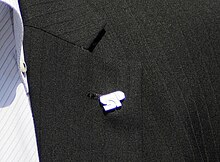|
Security Police (Japan)
The Security Police is the close protection division of the Tokyo Metropolitan Police Department.[1] Under the Security Bureau of the TMPD, the division is responsible for protecting domestic and foreign dignitaries on Japanese soil and abroad.[1][4] The division's agents are commonly known as Security Police (SP) (セキュリティポリス, Sekyuritī Porisu).[1][5] The word "SP" is a loanword used in the Japanese law enforcement system, based on the badge worn by the agents.[3]  The division does not protect the Imperial Family as they have their own dedicated division, the Imperial Protection Division.[1] HistoryAfter an assassination attempt against then–US Ambassador to Japan Edwin O. Reischauer in 1964, the chairman of the National Public Safety Commission was pressured to resign.[3] It was not until June 18, 1975, when then–Prime Minister Takeo Miki was attacked publicly by the Greater Japan Patriotic Party Secretary General Hiroyoshi Fudeyasu,[6] that the National Police Agency ordered the formation of the division.[6][2] The new unit was based on the US Secret Service.[7] The unit celebrated its 40th anniversary in 2015.[8] After the assassination of Shinzo Abe, SP officers were deployed to protect Akie Abe after she arrived in Kyoto as a precautionary measure.[9] On April 15, 2023, SP officers in the Saikazaki bombing incident were able to quickly move Fumio Kishida after a pipebomb was thrown near him.[10] ScandalsOn November 11, 2021, an SP officer was arrested for allegedly breaking into a women's-only condominium building.[11] DutiesThe division provides close protection duties for the following people:[3][12][13]
Although it is not mandated, the division also protects the Vice Speaker of the House of Representatives and the Vice President of the House of Councillors.[citation needed] Former prime ministers also receive SP protection.[14] This is provided at the discretion of the National Police Agency.[15] OrganizationThe division is structured in the following way:
Section 1 is mandated to protect the Prime Minister of Japan. Section 2 protects Ministers of States, the President of the House of Councillors, and the Speaker of the House of Representatives. Section 3 is known to conduct duties on guarding foreign VIPs such as ambassadors and heads of state while Section 4 are to protect the Chief Justice of Japan, the Governor of Tokyo, and others qualified for protection such as the Vice President of the House of Councillors, the Vice Speaker of the House of Representatives, and party leaders. In operations where SPs are deployed to other cities/towns in Japan and overseas, SP officers usually liaise with the local police in order to set up security for an incoming VIP or to scout potential locations where the VIP may visit.[15] Requirements SP officers start out as ordinary police officers, and must serve in the police for five years and have the rank of Sergeant in order to be a candidate.[3] Moreover, candidates are required to be more than 5 feet 8 inches tall (173 cm) (for male candidates),[16] achieve at least a third dan in at least one martial art, and have a high level of marksmanship.[3] SP candidates also need to speak English.[16] Both male and female police officers can qualify to join the division.[4] EquipmentOfficers are mostly armed with handguns and expandable batons during their duties. A mini flashlight and a transceiver is also in their list of equipment. Sometimes they used unmarked cars for transport and escort. They have used Mercedes-Benz S600, Toyota Crown, Nissan Teana, Nissan Elgrand, and Toyota HiAce. The officers carry mostly the NPA-issued Smith & Wesson Model 37 revolver, or the SIG P230 semi-automatic pistol. Officers can also be seen armed with pistols such as the Beretta 92,[17] Glock 17 or Heckler & Koch P2000.[18] Notes
References
Bibliography
Wikimedia Commons has media related to Security Police (Japan). |
||||||||||||||||||||
